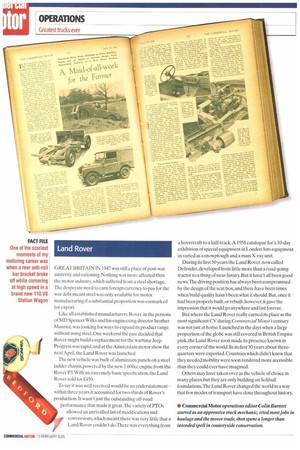Land Rover
Page 52

If you've noticed an error in this article please click here to report it so we can fix it.
GREAT BRITAIN IN 1947 was still a place of post-war austerity and rationing. Nothing was more affected than the motor industry, which suffered from a steel shortage. The desperate need to earn foreign currency to pay for the war debt meant steel was only available for motor manufacturing if a substantial proportion was earmarked for export.
Like all established manufacturers, Rover, in the persons of MD Spencer Wilks and his engineering director brother Maurice, was looking for ways to expand its product range without using steel. One weekend the pair decided that Rover might build a replacement for the wartime Jeep. Progress was rapid, and at the Amsterdam motor show the next April,the Land Rover was launched.
The new vehicle was built of aluminium panels on a steel ladder chassis, powered by the new 1,600cc engine from the Rover P3.With an extremely basic specification, the Land Rover sold for £450.
To say it was well received would be an understatement — within three years it accounted for two-thirds of Rover's production, It wasn't just the outstanding off-road performance that made it great.The variety of PTOs allowed an unrivalled list of modifications and conversions, which meant there was very little that a Land Rover couldn't do.There was everything from a hovercraft to a half-track.A 1958 catalogue for a 10-day exhibition of special equipment in London lists equipment as varied as a snowplough and a mass X-ray unit.
During its first 50 years the Land Rover, now called Defender, developed from little more than a road-going tractor to a thing of near-luxury. But it hasn't all been good news. The driving position has always been compromised by the design of the seat box, and there have been times when build quality hasn't been what it should. But, once it had been properly built,or rebuilt.however, it gave the impression that it would go anywhere and last forever.
But where the Land Rover really earned its place as the most significant CV during Commercial Motor's century was not just at home. Launched in the days when a large proportion of the globe was still covered in British Empire pink, the Land Rover soon made its presence known in every corner of the world. In its first 30 years about threequarters were exported. Countries which didn't know that they needed mobility were soon rendered more accessible than they could ever have imagined.
Others may have taken over as the vehicle of choice in many places, but they are only building on Solihull foundations,The Land Rover changed the world in a way that few modes of transport have done throughout history.
• Commercial Motor operations editor Cohn Barnett starred as an apprentice truck mechanic, tried most jobs in haulage and the motor trade, then spent a longer than intended spell in countryside conservation.






































































































































































































